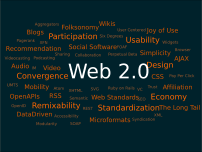The implications of streaming content on a “on demand basis” would make process integration dependent upon the complexity and trust of the cloud. Some talk of sky computing to ease the fear of one cloud holding too much power with cloud sharing and cross pollination reaping the most benefits to stakeholders. And would you say SaaS, DaaS and PaaS are also included within the Web2 meme? and if so, what implications therein?

- Image via Wikipedia
Cloud computing and DAM in Web 2.0?
I asked the following question on Linked at the MoDA (Masters of Digital Assets)
The implications of streaming content on a “on demand basis” would make process integration dependent upon the complexity and trust of the cloud. Some talk of sky computing to ease the fear of one cloud holding too much power with cloud sharing and cross pollination reaping the most benefits to stakeholders. And would you say SaaS, DaaS and PaaS are also included within the Web2 meme? and if so, what implications therein?
And a great answer came back from Micheal Moon
I see four big themes worthy of further discussion.
1. Cloud computing merely extends IT service management to a center of excellence—a business operation that guarantees levels of IT services (SLAs), change change management, and innovation many times higher that most internal IT organization can deliver. Cloud computing follows the well-documented trajectory of another “disruptive innovation”, delivering “good enough” value at prices so attractive that the low-end of the market opens up: new users or buyers can now enter. So cloud computing represents the full industrialization of IT service management and will continue to drive continuous improvement and innovation into IT service management. A very good thing.
2) Process integration thus emerges as strategic and mission critical. Most DAMs provide APIs; good enough for linking with other internal systems. Insufficient for business process management. With true BPM, service planners create dynamic policies, workflows, and routes; service planners create contingent scenarios, dynamically invoked by user request or external conditions. service planners use BPM for dynamic scheduling and collaboration across large social networks.
Thus, process integration with cloud-based services require a full BPM platform; however, unlike traditional BPMs from Tibco, BEA, IBM, rich-media BPMs must handle really large files.
3) Social media (postings, IM, blogs, forum threads) create context for specific pieces of content; social media serves as metadata. However most social media bears “unverified” information and, often, incorrect or libelous statements. Nonetheless, social media provides context and, therefore, supports me and you inferring meaning. NOTE: no intrinsic meaning ever exists in a file or information; only RGB dots; the rest (all of it), we make up.
4) A grand premise of social media entails URLs–hyperlinks–that link one piece of content to another, representing a “connection” that a user declares as meaningful. So, the biggest implication of cloud computing, DAM, and social media suggests that we must start modeling and codifying URLs with metadata; that we must treat a URL as a digital asset (even if the location or control of the particular assets resides in some else’s partition the Cloud.
Finally, this sets up an insight from years ago: Every digital asset has a unique URL; every URL constitutes an incipient if not declared digital asset. And who really, really get this as an organizing principle for a multi-billion dollar enterprise? in a word, Google. Who else, can you say iPod and iPhone?
Related articles by Zemanta
- An article about the future of cloud computing (holgerfrohloff.de)
- Software + Service Making More Sense (ducttapemarketing.com)
- A year in the clouds (infoworld.com)

Filmtools
Filmmakers go-to destination for pre-production, production & post production equipment!
Shop Now

![What role does cloud computing and DAM have in Web 2.0? 7 Reblog this post [with Zemanta]](http://img.zemanta.com/reblog_e.png?x-id=bbd095e4-e29e-49c2-a5e8-c85c300ab8ff)













